Key Specs
Since many of our users are going to want to run different OSes on this, we wanted to give some of the key hardware specs. There is a lot on these machines that are customizable, but this at least gives you some sense of what hardware is available. If you want to know if your hardware is compatible with your OS, this list should help do that tie-out.
CPU Support
Here are the officially supported CPUs for the 35W unit:
| PROCESSOR | TDP | Cores | Threads | SPEED | CACHE | INTEGRATED GRAPHICS |
| Intel Core i3-10100T | 35 W | 4 | 8 | 3.0 GHz to 3.8 GHz | 6 MB | Intel UHD Graphics 630 |
| Intel Core i3-10300T | 35 W | 4 | 8 | 3.0 GHz to 3.9 GHz | 8 MB | Intel UHD Graphics 630 |
| Intel Core i5-10400T | 35 W | 6 | 12 | 2.0 GHz to 3.6 GHz | 12 MB | Intel UHD Graphics 630 |
| Intel Core i5-10500T | 35 W | 6 | 12 | 2.3 GHz to 3.8 GHz | 12 MB | Intel UHD Graphics 630 |
| Intel Core i5-10600T | 35 W | 6 | 12 | 2.4 GHz to 4.0 GHz | 12 MB | Intel UHD Graphics 630 |
| Intel Core i7-10700T | 35 W | 8 | 16 | 2.0 GHz to 4.5 GHz | 16 MB | Intel UHD Graphics 630 |
| Intel Core i9-10900T | 35 W | 10 | 20 | 1.9 GHz to 4.6 GHz | 20 MB | Intel UHD Graphics 630 |
We are going to note that there are Pentium Gold options such as the G6500T and G6400T which are available, but we do not recommend those. HP also has higher-TDP 65W parts which we are omitting from this list because we are specifically reviewing the 35W TDP CPU unit here (we also have the 65W TDP unit.)
RAM Support
- Up to 2x 32GB DDR4 SODIMMs (64GB total) DDR4-2933/ 2666 depending on the CPU used
Storage Support
- 2x M.2 PCIe Gen3 for NVMe SSD slots
- 1x 2.5″ SATA (optional)
Networking (Wired)
- Intel i219-LM (Required for vPro)
WiFi Support (Optional)
- Intel Wi-Fi 6 AX201, 11ax 2×2 Wi-Fi + Bluetooth 5.1, Intel vPro technology support, M.2 Card
- Realtek RTL8822CE 802.11ac (2×2) with Bluetooth M.2 Combo Card
USB Ports
- 2x USB 3.2 Gen2 Front (1x Type-A, 1x Type-C)
- 2x USB 3.2 Gen2 Rear (Type-A)
- 2x USB 3.2 Gen1 Rear (Type-A)
- Options for additional ports, as configured with a USB 3.2 Gen1 Type-C with DisplayPort
OSes From Factory
- Windows 10 Home (64-bit)
- Windows 10 Professional (64-bit)
- Windows 10 Pro Education (64-bit)
- Windows 10 Enterprise (64-bit)
- FreeDOS 1.2
The OS section can be a big deal. Sometimes the units are advertised as supporting Windows 10, but one gets a Windows 10 Home or IoT license. If you want to, or may want to, run Windows 10 Pro, knowing exactly which OS is on the device is ultra important. HP is still focused on Windows OSes, but one can install Linux (it may require BIOS settings changes depending on how a unit is configured.) We also had our system running Proxmox VE as a Linux virtualization node but that is not an officially supported OS. Ubuntu installed without issue. One also usually needs to make BIOS tweaks in order to run Linux so be aware of that.
Note: These systems sometimes change specs mid-generation. If you find another spec sheet with items you think we should add, please let us know in the comments.
Next, we are going to look at the performance and power consumption before getting to our final words.
HP EliteDesk 800 G6 Mini 35W Performance and Power Consumption
Instead of going through the entire Linux-Bench test suite, we are going to show a few performance and power numbers here to give a general sense of performance. We actually planned to do storage testing, but then we realized that there was a huge variability in terms of what drives could be found in machines.
Python Linux 4.4.2 Kernel Compile Benchmark
This is one of the most requested benchmarks for STH over the past few years. The task was simple, we have a standard configuration file, the Linux 4.4.2 kernel from kernel.org, and make the standard auto-generated configuration utilizing every thread in the system. We are expressing results in terms of compiles per hour to make the results easier to read:
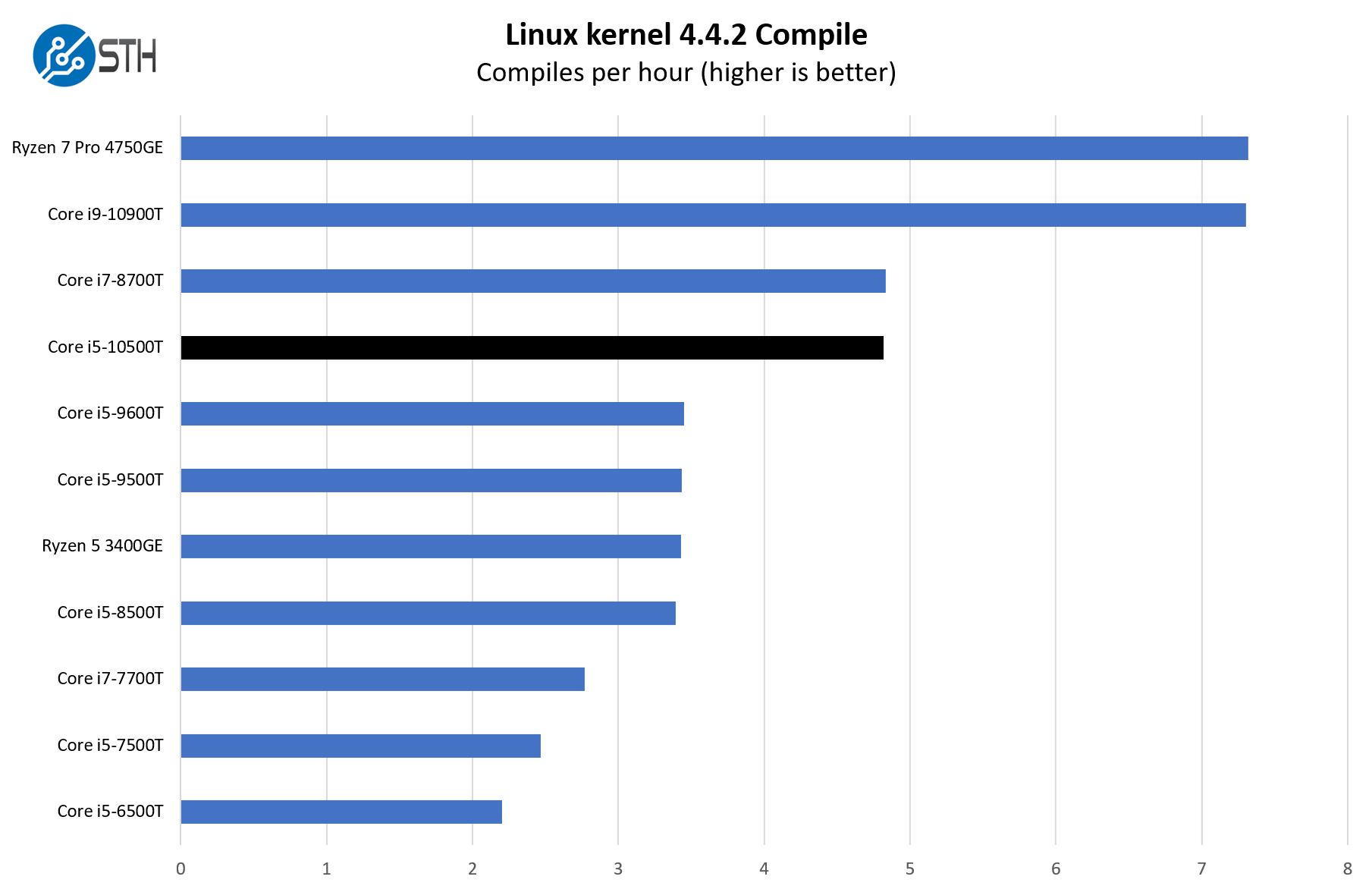
For those who read our Dell OptiPlex 7080 review, this section is going to be similar. We saw a performance of the Core i5-10500T with the 90W power adapters, which were almost identical within a 1.5% test variation on these tests. If you saw that review, this is going to seem very repetitive.
7-zip Compression Performance
7-zip is a widely used compression/ decompression program that works cross-platform. We started using the program during our early days with Windows testing. It is now part of Linux-Bench.
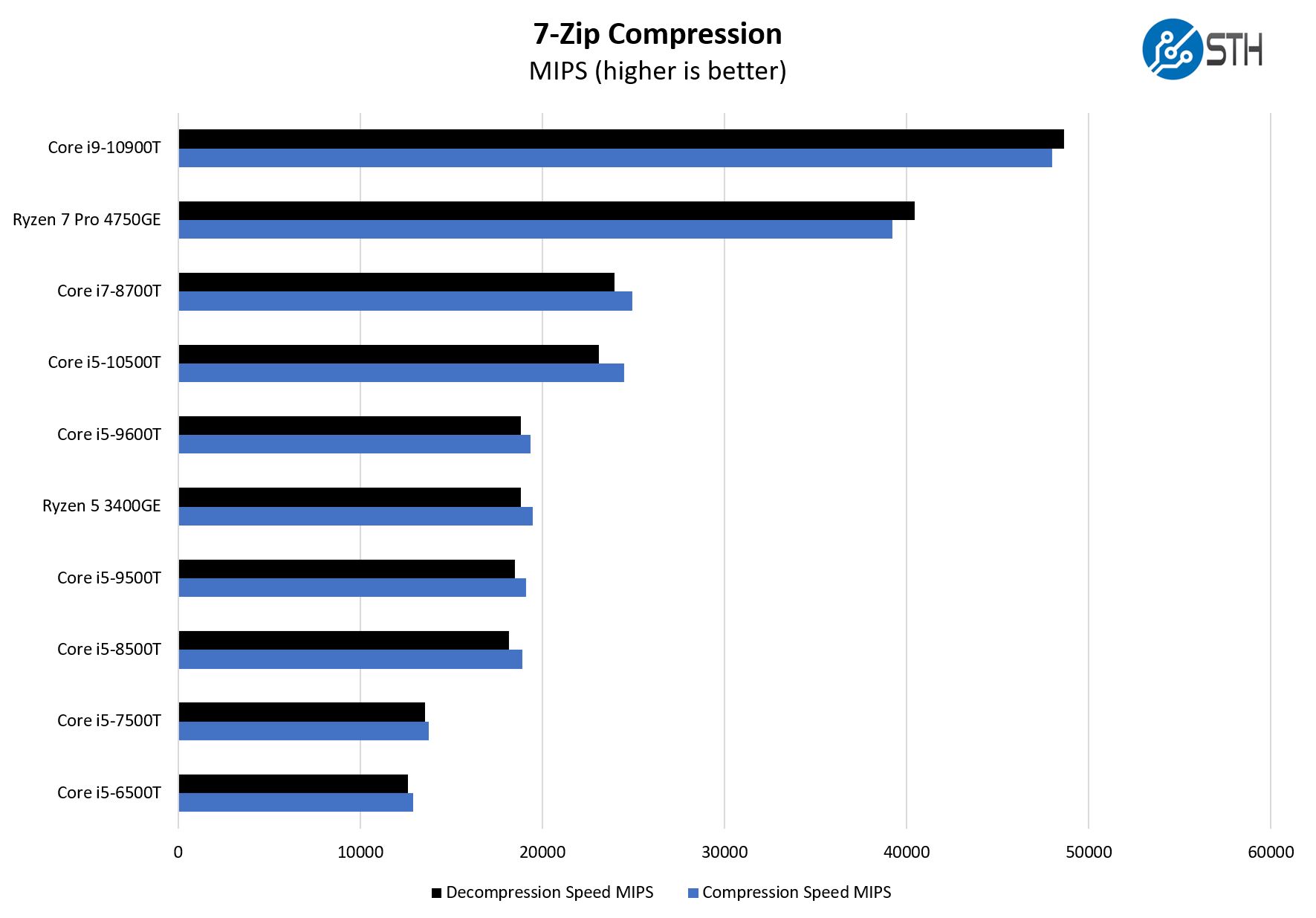
Something we are trying to show in these charts is the progression from the Core i5-6500T to the Core i5-10500T. Adding Hyper-Threading in this segment (finally) is yielding some solid performance gains. Here is a quick snapshot of the line over five generations:
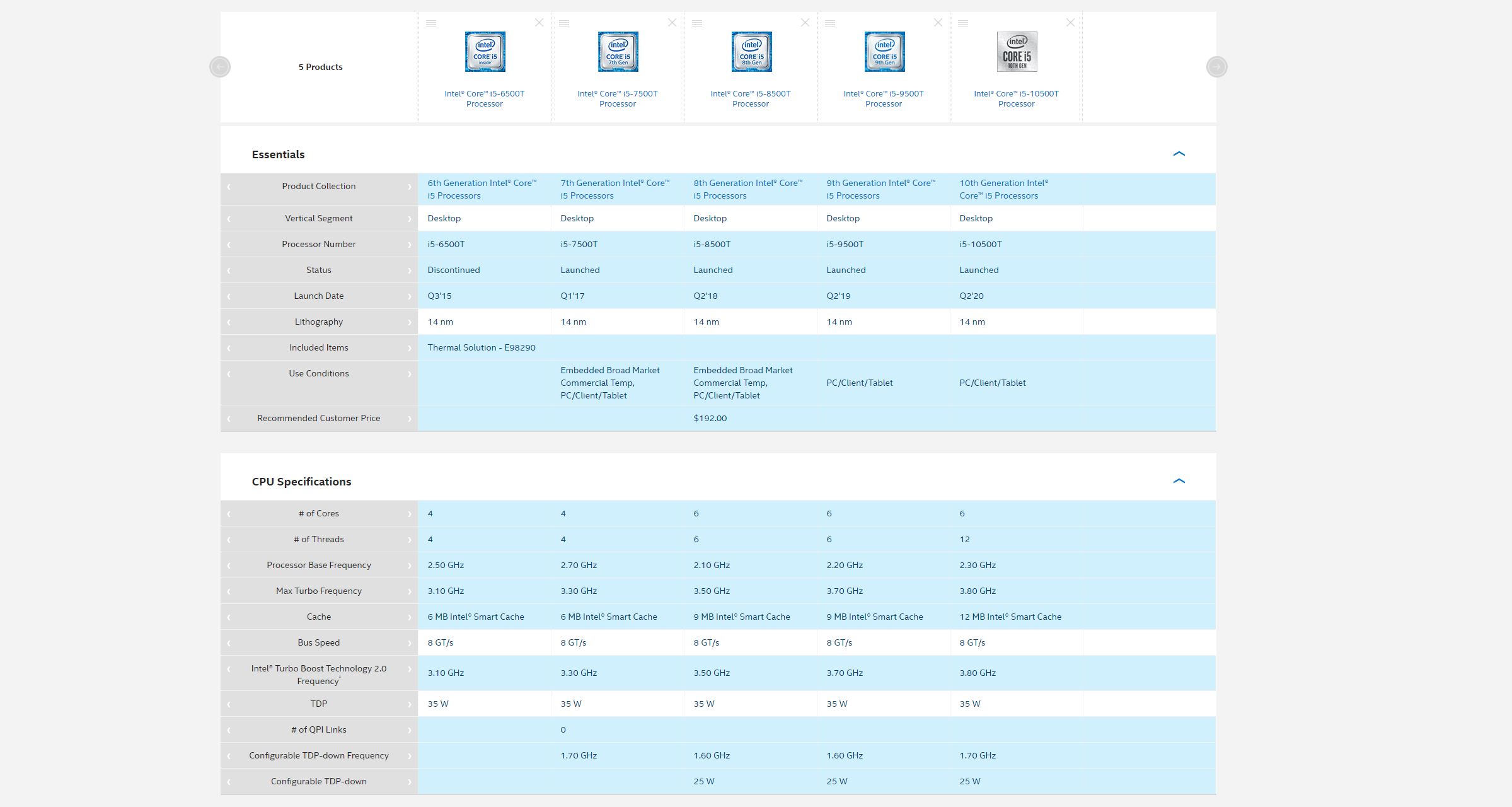
The key is that pre-Ryzen we had 4 cores/ 4 threads and small generational improvements. Now post-AMD Ryzen, we are at 6 cores/ 12 threads and around twice the performance of the Core i5-6500T.
OpenSSL Performance
OpenSSL is widely used to secure communications between servers. This is an important protocol in many server stacks. We first look at our sign tests:
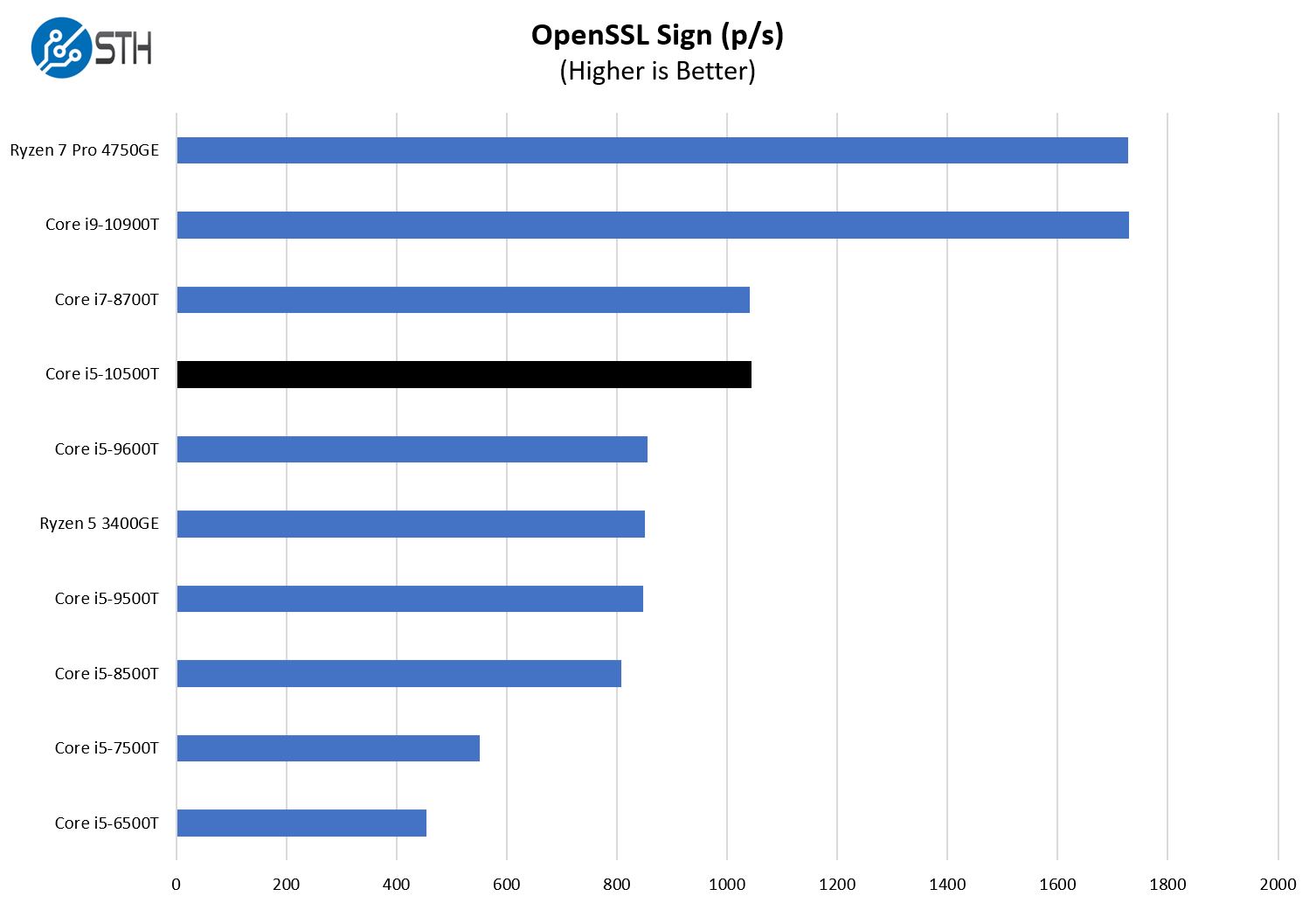
Here are the verify results:
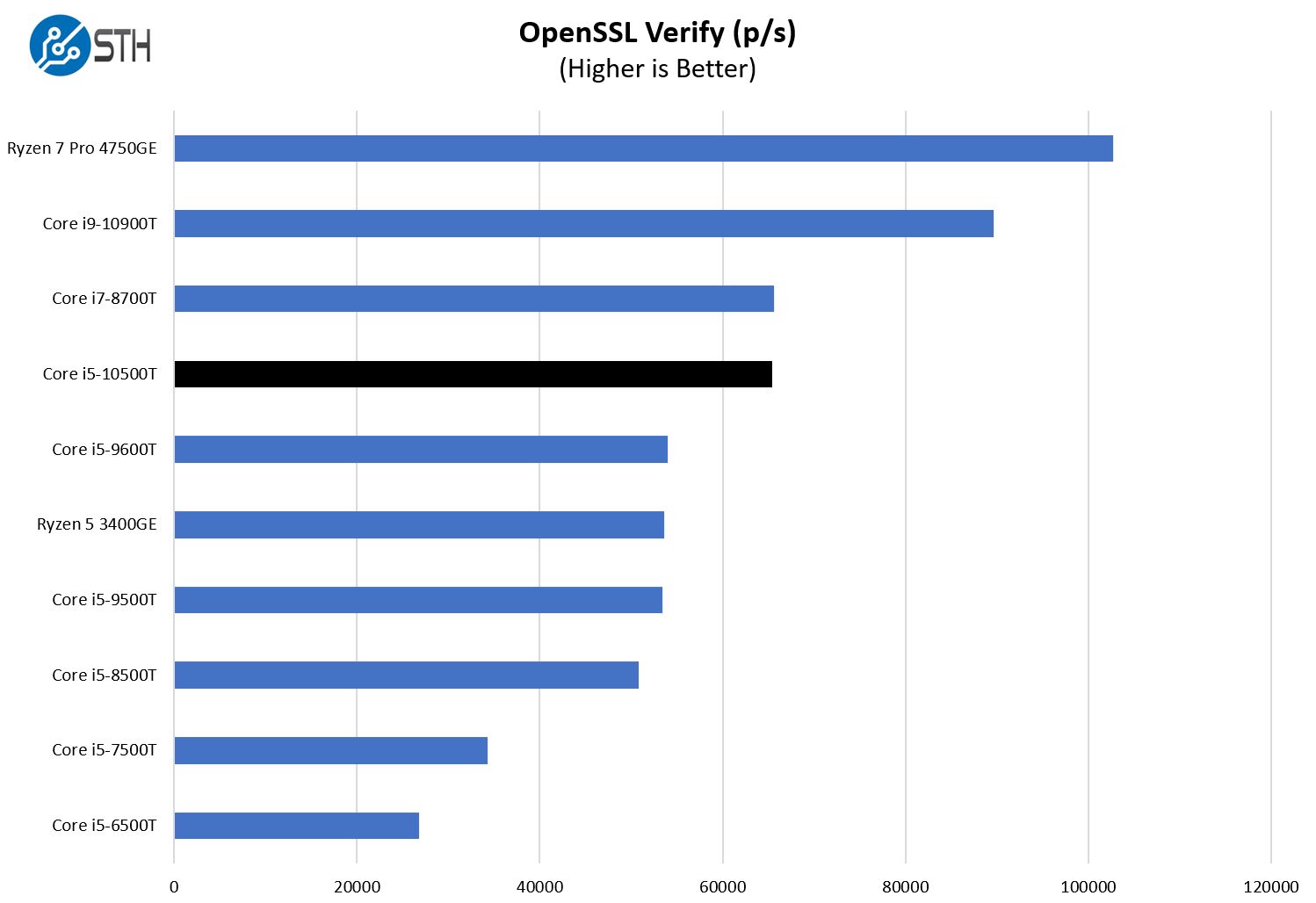
This chip is roughly equivalent to an Intel Core i7-8700T. They are not the same, but the performance in our testing was very close. The Core i7-8700T had the same 6 cores/ 12 threads and 12MB of L3 cache along with somewhat similar clock speeds. Perhaps this makes sense. We feel fairly comfortable saying we have Core i7 performance at the Core i5 level two generations later, just with newer features such as more USB 3.2 Gen2 from the Q470 PCH and the newer platform. We also get a fairly massive performance jump over the previous-generation Core i5-9500T/ i5-8500T parts without Hyper-Threading.
Next, we are going to take a look at power consumption before getting to our key lessons learned and final words.



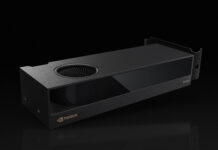
It’s available in a high-performance version with support for 95W CPUs (I have a i9-10900K CPU in mine). Why would you bother with an anemic laptop-grade CPU?
You can stop this Windows license costs $140 meme. Legit oem license is under $10 for everyone who cares to do a little search.
A Raspberry Pi 4 with 8 GB of memory is 1/8 the price of this thing, and you can stick in a 128 GB micro card. Plus USB 3, and HDMI. Anyone still using Windows is stuck in the 90’s. Linux and it’s apps win hands down.
These run Linux as well as other OSes, and of course WSL lets you run Linux on Windows/ you can hyper-v virtualize other OSes as well. The challenge with the RPi 4 is that one needs to add the cost of a power adapter chassis and drive. The 128GB SD card is not a competitor for a NVMe SSD and USB 3 is still not the Gen2 on this. The idea behind this series was to look at something bigger than a Raspberry Pi 4 so that you can create VMs that are the equivalent of a RPi 4 cluster on a single box.
Hey Patrick, just a quick note, this article isn’t tagged with #TinyMiniMicro. I haven’t checked out some of the other articles. Having the tag definitely helps me do comparison shopping. Thank you ever so much for this series. The only downside is ebay is a little more competitive than it used to be! 😉
Has anyone managed to find the 2.5GbE NIC for the flex port please? I can’t find it for sale and can’t even find a part number. Any help welcome.
2.5GbE NIC for the flex port please?